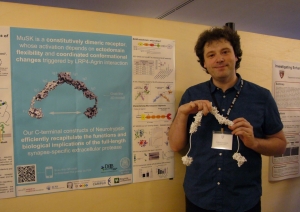Federico Forneris
Abstract

Molecular architectures, interactions and functions of neuromuscular synapse organizers
Synapse formation is a finely-tuned process requiring multiple steps and a variety of receptors and signaling molecules. The neuromuscular synapse or junction (NMJ) – the connection between motor neurons and skeletal muscles – represents the archetype junction system for studying synapse formation and conservation. NMJ formation requires coordinated interactions between motor neurons and muscle fibers, which ultimately result in the construction of a highly specialized postsynaptic architecture juxtaposed to a highly differentiated nerve terminal. Our research focuses on the investigation of the key signaling molecules and receptors that enable NMJ formation and stabilization.
We study the extracellular architecture and function of two subsets of proteins tied to the role of agrin, a well known NMJ stabilizer. The first subset includes the agrin receptor, comprising the receptor tyrosine kinase MuSK (muscle-specific kinase) and its co-receptor LRP4; the second includes the soluble synapse-specific regulatory protease Neurotrypsin (NT) that cleaves agrin with high specificity. This focus has yielded novel insight into processes underlying NMJ formation. In the first case, crystal structures of MuSK ectodomain fragments, coupled with solution scattering data and cross-linking mass spectrometry, highlighted the contribution of molecular flexibility in receptor activation and signaling. In the second case, in vitro enzyme studies and cell-based assays elucidated the specificity of NT, revealing a delicate regulatory mechanism mediated by splicing variants, ion binding, and post-translational modifications. Our results offer new understanding of NMJ formation and stabilization, and contribute innovative tools to the characterization of this fundamental biological system.
